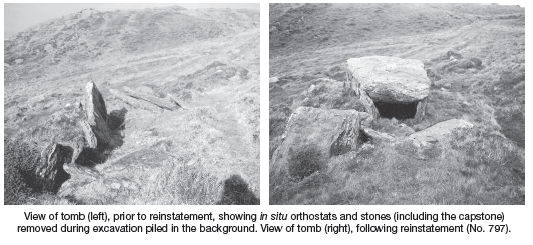County: Kerry Site name: COOMATLOUKANE
Sites and Monuments Record No.: KE106-037 Licence number: 03E1768
Author: Ann Lynch, National Monuments Section
Site type: Megalithic tomb - wedge tomb
Period/Dating: Neolithic (4000BC-2501 BC)
ITM: E 450918m, N 560336m
Latitude, Longitude (decimal degrees): 51.775448, -10.160456
The monument reinstated is one of four wedge tombs excavated by Professor Michael Herity in the late 1960s. Known locally as Bórdóinín, the tomb—at Coomatloukane, Caherdaniel—was described by the Megalithic Survey in 1966 as ‘partly collapsed’. The capstone was pitched at a sharp angle resting against the two upright slabs which formed the southern side of the chamber. The single visible sidestone on the north side was lying prostrate underneath the collapsed edge of the capstone.
The results of the excavations have not been published, but, in his paper, ‘The Prehistoric Peoples of Kerry’, Herity (1970) indicated that no grave goods were found, with the exception of a cremated burial from one of the tombs (not the tomb in question here). The collapsed capstone and sidestones of Bórdóinín had been moved to one side to facilitate the excavation, but the tomb was not reinstated following completion of the project. Local representation was made to the National Monuments Section of the Department of the Environment, Heritage and Local Government in 2001/2002 to have the tomb reinstated, as it is located adjacent to the 18th-century ‘Daniel O’Connell’s Road’, which is now part of the Kerry Way walking route. The work was carried out in November 2003 under the direction of the writer Grellan Rourke, a conservation architect.
An area 3.5m by 1.5m, coinciding with the chamber, was de-sodded. A layer of flat stones placed over the backfilled chamber area and a single low rectangular stone set on edge, which may have been a packing stone for one of the northern sidestones, were revealed. Without access to any of the excavation records, it was not known whether sockets for the collapsed sidestones had been located during the earlier excavation. The area bounding the north side of the chamber was trowelled back, but no trace of sockets was revealed, indicating that they must have been shallow in the first instance. This could also account for the sidestones collapsing in antiquity. Using the span of the capstone and the position of the probable packing stone for guidance, two new sockets were excavated to take the orthostats, which had been stacked to one side of the tomb. The capstone was then manoeuvred into position using a Hy-Mac with canvas slings.
The only ground disturbance which took place during the reinstatement was the excavation of the two new sockets. No features or artefacts of archaeological significance were recorded.
Reference
Herity, M. 1970 ‘The prehistoric peoples of Kerry’, Journal of the Kerry Archaeological and Historical Society 3, 11–13.

Department of the Environment, Heritage and Local Government, Dún Scéine, Harcourt Lane, Dublin 2